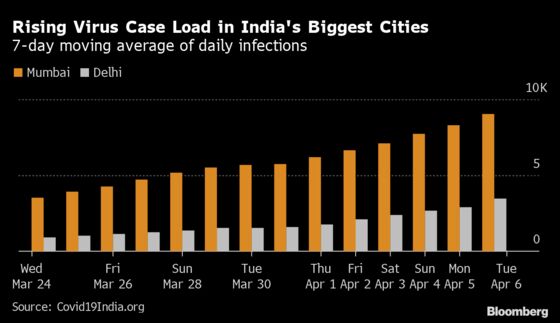
RBI Pledges to Buy Bonds While Holding Rates as Infections Surge
(Bloomberg) --
India’s central bank pledged to buy 1 trillion rupees ($13.5 billion) of bonds this quarter to cap borrowing costs to support an economy facing a resurgence of coronavirus infections. Bonds and stocks rallied.
The Reserve Bank of India’s monetary panel will also act to support growth by retaining its accommodative stance for as long as necessary, Governor Shaktikanta Das said after the central bank held the benchmark repurchase rate at a record low 4% -- a decision predicted by all 30 economists surveyed by Bloomberg.

Policy makers in India have had a tough balancing act, where a desire to do more to support the economy has to be balanced with persistent inflation pressure and rising bond yields. A nascent recovery in Asia’s third-largest economy has been disrupted by a jump in virus infections to a record of more than 100,000 this week.
“The recent surge in infections has, however, imparted greater uncertainty to the outlook,” Das said. “Localized and regional lockdowns could dampen the recent improvement in demand conditions and delay the return of normalcy.”
The 10-year bond yield dropped 12 basis points from an intraday high of 6.19% to 6.07%, while the rupee fell 0.5% against the dollar. The benchmark stock index extended gains to rise 0.8%.
“We can definitely see it as a quantitative easing program and markets taking it very positively,” said Naveen Singh, head of fixed-income trading at ICICI Securities Primary Dealership in Mumbai. “Still, it would be a challenge to keep absorbing the huge supply at prevailing prices.”
The debt purchases will start from April 15, Das said. The governor had earlier said the RBI had bought 3 trillion rupees worth of bonds in the previous fiscal year ended March, and planned similar or more spending for the new year.
The central bank also retained its growth outlook for the fiscal year started April 1 at 10.5%, unchanged from its February forecast.
Although inflation at 5.03% in February was within the the central bank’s 2%-6% target band, sticky underlying price pressures have been a problem for policy makers. That’s because higher fuel and volatile food prices, which make up more than 50% of the consumer price index, are causing second round effects.
The RBI revised the outlook for prices, with inflation seen at 5% in the fourth quarter of last fiscal year. That’s above the 4% midpoint of the central bank’s target band.
“Against this backdrop, the RBI should remain accommodative to support and nurture the recovery,” Das said. “The stance of monetary policy will remain accommodative till the prospects of sustained recovery are well-secured.”
©2021 Bloomberg L.P.